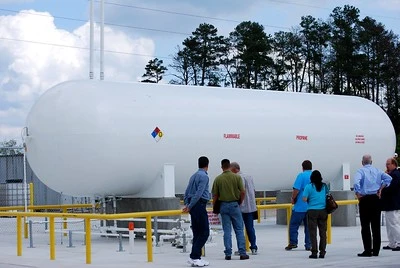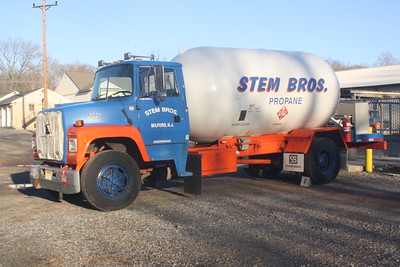
Propane is a versatile and essential fuel used in households and industries for heating, cooking, and powering equipment. Knowing the cheapest time of year to buy propane can lead to significant savings.
This article explores propane price fluctuations and seasonal trends to help you make cost-effective purchasing decisions. By understanding these changes, you can buy propane at its lowest price, ensuring you get the best value for your money.
But let’s answer the question first:
The cheapest time of year to buy propane is usually late summer to early fall, around August to October. During these months, demand is low because fewer people need propane for heating. This period is often called the “off-peak season” in the industry.
In the propane industry, suppliers have higher “inventory levels” during this time, meaning they have more propane in storage. Because there’s less “peak demand” for heating, they lower prices to sell their excess supply. You might see prices drop by as much as 20% compared to the high-demand winter months.
By buying propane during this off-peak season, you can take advantage of these lower prices and save money.
Need a Propane Refill?
Running low on propane? Don’t overpay or waste time calling around. We’ll connect you with a reliable local supplier who offers safe service and a fair, competitive price for your refill.
✉️ Contact Us For Your NeedGet connected today and enjoy peace of mind knowing your propane refill is fast, safe, and at a good price.
Why Is Late Summer to Early Fall the Best Time of the Year to Buy Propane
Late summer to early fall, typically from August to October, is the best time to buy propane for several key reasons:
- Low Demand: During these months, the demand for propane is significantly lower because fewer people need it for heating. This period is known as the “off-peak season” in the industry.
- High Inventory Levels: Propane suppliers often have high inventory levels, meaning they have a substantial amount of propane in storage. For example, inventory levels can be 10-15% higher during this time compared to the winter months.
- Lower Prices: With high supply and low demand, suppliers reduce prices to attract buyers. Propane prices can drop by as much as 20% compared to the peak winter season. For instance, if propane costs $2.50 per gallon in winter, it might drop to around $2.00 per gallon in late summer.
- Less Competition: Fewer people are looking to buy propane during late summer and early fall, reducing the competition and pressure on prices that come with the high-demand winter season. This can further help keep prices lower and more stable.
By purchasing propane during this off-peak season, you can take advantage of these lower prices and ensure you have enough fuel before the winter demand spikes. This strategic timing can lead to significant savings and better budget management for your propane needs.
How About Winter and Spring
Winter (December to February)
- High Demand: During winter, the demand for propane increases significantly because many people use it for heating their homes. This period is known as the “peak season” in the industry.
- Higher Prices: With increased demand, propane prices can rise sharply. For example, prices can increase by 30% or more during the coldest months. If propane costs $2.00 per gallon in the summer, it might jump to $2.60 or more in the winter.
- Limited Supply: Suppliers may have lower inventory levels as they deplete their stocks to meet the high demand. This scarcity can drive prices up even further.
Spring (March to May)
- Decreasing Demand: As temperatures begin to warm up, the demand for propane decreases. This period marks the transition from the peak heating season to the off-peak season.
- Stabilizing Prices: With lower demand, prices start to stabilize and may begin to drop. While prices in spring may not be as low as in late summer, they are generally lower than in winter. For instance, propane prices might decrease by 10-15% from their winter peak.
- Restocking Supply: Suppliers start to rebuild their inventory levels in preparation for the next heating season. This restocking can lead to more stable prices as supply catches up with demand.
Seasonal Trends in Propane Prices
Explanation of How Propane Prices Vary with Seasons
Winter (December to February)
- High Demand: In winter, many people use propane for heating, which causes demand to go up.
- Higher Prices: Prices can increase by 30% or more during these months. For example, if propane costs $2.00 per gallon in summer, it might rise to $2.60 per gallon in winter.
Spring (March to May)
- Decreasing Demand: As the weather warms up, fewer people need propane for heating, so demand goes down.
- Stabilizing Prices: Prices start to drop, usually by 10-15% from their winter peak. If propane was $2.60 per gallon in winter, it might decrease to around $2.20 per gallon in spring.
Summer (June to August)
- Low Demand: Summer has the lowest demand for propane since it’s mostly used for grilling and not heating.
- Lower Prices: Prices can be up to 20% lower than in winter. For example, propane could be around $2.00 per gallon in summer.
Fall (September to November)
- Low Demand Continues: Early fall still sees low demand, but it starts to pick up as people prepare for winter.
- Best Time to Buy: Late summer to early fall is the best time to buy propane. Prices are usually at their lowest, around $2.00 per gallon or even less.
Data Analysis of Propane Prices Throughout the Year
Here’s a simplified chart showing how propane prices might change throughout the year:
| Month | Price per Gallon |
|---|---|
| January | $2.60 |
| February | $2.55 |
| March | $2.30 |
| April | $2.20 |
| May | $2.15 |
| June | $2.00 |
| July | $1.95 |
| August | $1.90 |
| September | $1.95 |
| October | $2.00 |
| November | $2.20 |
| December | $2.60 |
This chart shows the general trend: highest prices in winter, dropping through spring, lowest in summer, and then gradually increasing again in fall. By understanding these trends, you can plan to buy propane when it’s cheapest and save money.
Tips for Saving on Propane Costs
Strategies for Purchasing Propane at the Lowest Prices
- Pre-Buy Programs: Many propane suppliers offer pre-buy programs where you can purchase propane in advance at a fixed price. This helps you avoid price spikes during the winter. For example, you might lock in a summer price of $2.00 per gallon instead of paying $2.60 per gallon in the winter.
- Price Protection Plans: Some suppliers offer price protection plans that set a cap on how high the price can go, protecting you from extreme price increases. These plans might have a small fee but can save you money if prices rise significantly.
- Off-Season Purchases: Buy propane during the off-peak season (late summer to early fall) when demand is low and prices are at their lowest. Prices can be up to 20% cheaper during this time.
Importance of Planning and Monitoring Propane Usage
- Regular Monitoring: Keep an eye on your propane usage throughout the year. Regularly check your tank levels to avoid emergency fill-ups, which can be more expensive.
- Usage Planning: Plan your propane usage to avoid running out during peak times. Use programmable thermostats to control heating efficiently and reduce unnecessary usage.
- Energy Efficiency: Invest in energy-efficient appliances and insulation to reduce overall propane consumption. This can lower your heating costs and make your propane last longer.
Benefits of Bulk Purchasing and Storage
- Cost Savings: Buying propane in bulk can lead to significant discounts. For example, purchasing a large tank refill might cost less per gallon compared to smaller, more frequent purchases.
- Consistent Supply: Having a large storage tank ensures you have a consistent supply of propane, especially during high-demand winter months. This means you won’t need to worry about running out and facing higher prices for urgent refills.
- Flexibility: Bulk purchasing allows you to take advantage of lower prices when they are available. You can buy a large amount when prices are low and store it for use throughout the year.
To Make a Conclusion
Understanding the seasonal trends in propane prices can significantly impact your budget. Late summer to early fall, typically from August to October, is the best time to buy propane due to lower demand and higher inventory levels, leading to the lowest prices of the year.
By planning your purchases during this off-peak season and considering strategies such as pre-buy programs and bulk purchasing, you can take advantage of these lower prices and ensure a steady supply for your needs. Being proactive and informed about propane price fluctuations will help you save money and manage your energy costs more effectively.

Mike is an experienced propane technician with over 15 years of professional experience in the field. He has dedicated his career to helping customers with their propane needs, from installation to maintenance and repair. Together with Jeremy, he co-founded this website to provide useful information and guidance to customers seeking reliable propane services.




